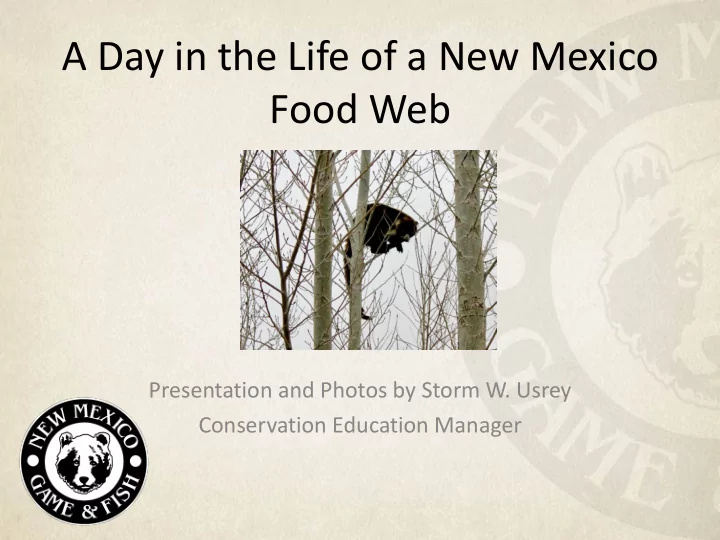

A Day in the Life of a New Mexico Food Web Presentation and Photos by Storm W. Usrey Conservation Education Manager
Goal • Students will understand what a food web is, how various species fit into this important biological concept and, as some populations increase or decrease, how this can impact other species within the web. Objectives • Students understand the importance of food webs. • Students will be able to define key vocabulary words such as herbivore, omnivore and carnivore. • Students will be able to define autotroph and heterotroph. • Students will know how drastic species population changes can impact the food web. • Students will know that toxins accumulated within the food web can possibly affect many species over time. Images credit: Office.com
Definitions • Autotroph – organism capable of synthesizing its own food from inorganic material (e.g. plants photosynthesize their own food). • Bioaccumulation – gradual accumulation of a substance, such as pesticides or other chemicals, in an organism. • Carnivore – organism that eats mainly meat from other animals. • Decomposers – organism that breaks down dead or decaying organisms or waste. • Detritivore – organism that feeds on waste products or dead organic material (mostly animals).
Definitions • Food Chain – is a linear network of links in a food web. • Food Web – model depicting the many food chains linked together to show the relationship of organisms in the ecosystem. • Herbivore – organism that eats only plants. • Heterotroph – organism that cannot produce its own food. • Omnivore – organism that eats plants and animals. • Primary Consumer – organism that feeds on primary producers. Organisms here are herbivores.
Definitions • Producers – organisms that make their own food. • Saprovore – organisms that feed on dead organic matter (mostly fungi). • Secondary Consumer – organism that feeds on primary consumers. Organisms here can be omnivores or carnivores. • Tertiary Consumer – organism that feeds on primary or secondary consumers. Organisms here are usually carnivores, but can be omnivores. • Trophic level – position an organism occupies in a food web.
Food Webs • Food webs are found all around us in the world. It is very important to understand this key biological concept. • Food webs show us how all species interact and how energy is transferred between trophic levels. • Food chains are part of food webs; both are visual representatives of how organisms acquire their energy.
Food Webs • The sun gives plants energy. • Photosynthesis produces food for plants. Plants are autotrophs. • As you move up a food web or chain, organisms consume other organisms to obtain their energy. These organisms are called heterotrophs. Image credits on this slide: Office.com
Food Webs • Deer browse on leaves, turkeys eat acorns and insects, black bears eat berries and elk, cougars eat deer and bighorn sheep. These are examples of other organisms consuming other organisms. • Deer are herbivores, turkeys and bears are omnivores and cougars are carnivores.
Food Webs • Decomposers are important as they break down dead material that plants use as food to obtain their nutrients. • Can you name some decomposers in nature? Image credit: Office.com
Hierarchy of a Food Web • Examples of producers are trees, brush, flowers and grass. • Examples of primary consumers would be elk, deer, grasshoppers and chipmunks. • Examples of secondary consumers would be wild turkeys, lizards, foxes and coyotes. • Examples of tertiary consumers would be cougars, black bears and bald eagles. • Examples of decomposers would be maggots, earth worms and fungus.
Hierarchy of a Food Web Tertiary As consumers and Consumer even producers die, they are broken down Secondary into nutrients by decomposers, which Consumer aid producers in growing. Primary Consumer Producer Decomposers
Energy Transfer in a Food Web • Only about 10% of energy is transferred between trophic levels. 90% is used by each trophic level for mechanical and heat processes. • That is why when you look at a pyramid it is wider at the bottom than the top. • There are more producers than herbivores, and more herbivores than omnivores/carnivores. 10% 10% 10% Image credit: Office.com
How Organisms make a living Heterotroph Heterotroph Heterotroph Autotroph Heterotroph
-vore in a Hierarchy Usually carnivore, but can be omnivore Omnivore or Carnivore Herbivore Autotroph Autotroph and Decomposers image credit: Office.com Saprovore or Detritivore
Examples of Organisms in a Food Web Tertiary Consumers Secondary Consumers Coyote image credit: Office.com Primary Consumers Grasshopper image credit: Office.com Producers Producers Image credits: Office.com
Examples of Organisms in a Food Web Tertiary Consumers Secondary Consumers Coyote image credit: Office.com Primary Consumers Grasshopper image credit: Office.com Producers Image credits: Office.com
Bioaccumulation (Biomagnification) • When pesticides containing DDT were used, the chemicals entered the water system. • All species in the system from plankton to fish accumulated DDT. • This drastically impacted higher organisms on the food web such as bald eagles and ospreys when they fed on fish that had DDT. Images on this slide credit: Office.com
Bioaccumulation (Biomagnification) • Eagles would feed on fish and over time the accumulation of DDT infected fish meat eaten by eagles, impacting eagle populations. • DDT affected bird egg development and egg shells were not developing correctly. • Caused bald eagles populations to drastically decline. Images on this slide credit: Office.com
Thank You! Please plan on going hunting, fishing or trapping in the future and know that your purchase of a license for any of these activities helps fund wildlife and fisheries management in the Land of Enchantment!
Recommend
More recommend